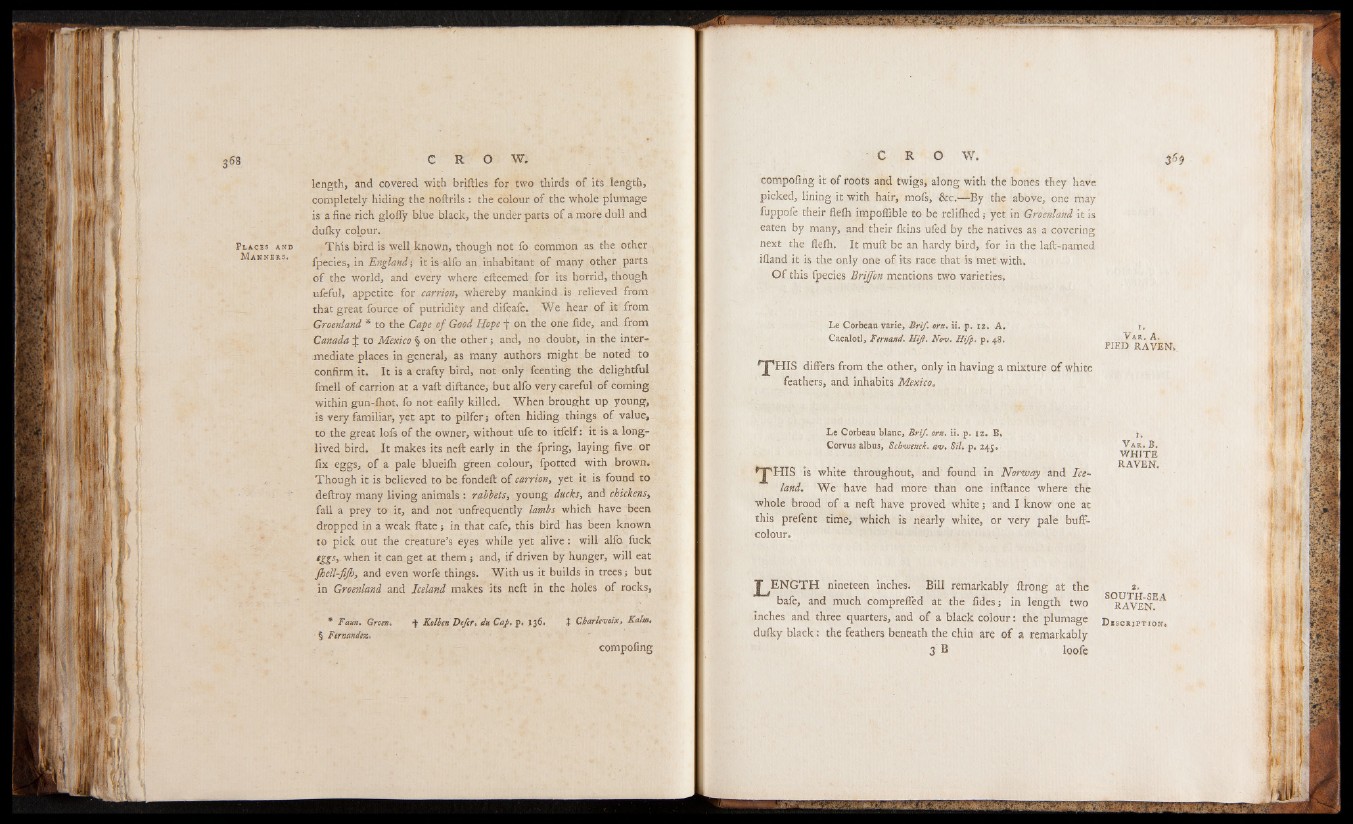
368 C R O W .
P lace s and
M a n n e r s .
length, and covered with briftles for two thirds of its length,
completely hiding the noftrils : the colour of the whole plumage
is a fine rich glofly blue black, the under parts o f a more dull and
dufky colpur.
This bird is well known, though not fo common as the other
fpecies, in England; it is alfo an inhabitant of many other parts
of the world, and every where efteemed for its horrid, though
ufeful, appetite for carrion, whereby mankind is relieved from
that great fource of putridity and difeafe. We hear of it from
Groenland * to the Cape of Good Hope on the one fide, and from
Canada J to Mexico § on the other; and, no doubt, in the intermediate
places in general, as many authors might be noted to
confirm it. It is a crafty bird, not only fcenting the delightful
fmell of carrion at a vaft diftance, but alfo very careful of coming
within gun-ihot, fo not eafily killed. When brought up young,
is very familiar, yet apt to pilfer; often hiding things of value,,
to the great lofs of the owner, without ufe to itfelf: it is a longr
lived bird. It makes its neft early in the fpring, laying five or
fix eggs, of a pale blueilh green colour, fpotted with brown.
Though it is believed to be fondeft of carrion, yet it is found to
deftroy many living animals : rabbets, young ducks, and chickens,
fall a prey to it, and not unfrequently lambs which have been
dropped in a weak ftate; in that cafe, this bird has been known
to pick out the creature’s eyes while yet alive; will alfo fuck
eggs,, when it can get at them ; and, if driven by hunger, will eat
fhell-fijh, and even worfe things. With us it builds in trees; but
in Groenland and Iceland makes its neft in the holes of rocks,
# Faun, Groen, *}• Kolhen Defer, du Cap, p. 136. J Charlevoix, Kalm.
■ § Fernandez, '
com p o fin g
C R O W .
compofing it of roots and twigs, along with the bones they have
picked, lining it with hair, mofs, &c.— By the above, one may
fuppofe their flelh impollible to be relilhed; yet in Groenland it is
eaten by many, and their lkins ufed by the natives as a covering
next the flelh. It muft be an hardy bird, for in the laft-named
ifland it is the only one of its race that is met with.
Of this lpecies Briffon mentions two varieties.
Le Corbeau varie, B r if. orn. ii. p. 12, A. 1.
Cacalotl, Fernand. H iß . Nov. Hifp. p. 48. V ar . A. * " ? PIED RAVEN.
^ H I S differs from the other, only in having a mixture of white
feathers, and inhabits Mexico.
Le Corbeau blanc, Brif. orn. ii. p. 12. Bk
Corvus alb us, Schwenck. am. Sil. p, 245»
'J 'H IS is white throughout, and found in Norway and Iceland.
We have had more than one inftance where the
whole brood of a neft have proved white; and I know one at
this prelent time, which is nearly white, or very pale buff-
colour.
r.
V a r . B. RWAHVIETNE.
1~ JENGTH nineteen inches. Bill remarkably ftrong at the a.
bafe, and much comprefied at the fides; in length two S<raatenEA
inches and three quarters, and of a black colour; the plumage D i s c r e t io n .
dulky black; the feathers beneath the chin are of a remarkably
3 B lo o fe